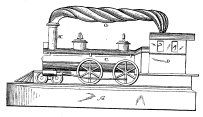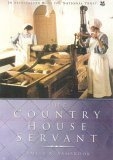-
History of:
- Resources about:
- More:
- Baby walkers
- Bakehouses
- Bed warmers
- Beer, ale mullers
- Besoms, broom-making
- Box, cabinet, and press beds
- Butter crocks, coolers
- Candle snuffers, tallow
- Clothes horses, airers
- Cooking on a peat fire
- Drying grounds
- Enamel cookware
- Fireplaces
- Irons for frills & ruffles
- Knitting sheaths, belts
- Laundry starch
- Log cabin beds
- Lye and chamber-lye
- Mangles
- Marseilles quilts
- Medieval beds
- Rag rugs
- Rushlights, dips & nips
- Straw mattresses
- Sugar cutters - nips & tongs
- Tablecloths
- Tinderboxes
- Washing bats and beetles
- Washing dollies
- List of all articles
Subscribe to RSS feed or get email updates.
Then I had to iron all these clothes with a charcoal iron. Everything was starched. So you were going along beautifully with a charcoal iron, and when you're just almost finished, the ashes come out and it gets stuck on the article......
Memories of early 20th century Hawaii from:
Eleanor Arnold, Voices of American Homemakers, 1993
This book has about 100 pages on old laundry practices:
The Country House Servant from Amazon.com
Or from Amazon.UK
Charcoal irons and birds
 Birds
seem to belong on charcoal irons - but why? Not only is there at least one 21st
century
Chinese charcoal iron with a bird perched on the "prow" being sold widely
across Asia and Africa, but this design has been around for a long time. Several
museums in East European countries display
vintage irons with a rooster (cockerel) sitting on the front.
Birds
seem to belong on charcoal irons - but why? Not only is there at least one 21st
century
Chinese charcoal iron with a bird perched on the "prow" being sold widely
across Asia and Africa, but this design has been around for a long time. Several
museums in East European countries display
vintage irons with a rooster (cockerel) sitting on the front.
Why is a rooster a common decoration for a charcoal-filled box iron? For a start it’s not just an ornament, it’s also a good shape for the catch to open the lid. This design seems to have stayed pretty much the same for at least a century across a couple of continents.* The bird on the (German?) iron to the right seems closely related to his counterpart on a vintage Russian iron, but is he definitely a rooster?
Do let us know if you can throw light on this iron design. Was it manufactured in some factory behind the iron curtain, and spread throughout friendly parts of Europe and Asia? And what about its arrival in South and Central America? Does any culture make a link between rooster symbolism and ironing? Or is it just an enduring popular classic?
* Since writing this, I've read Glissman's book on The Evolution of the Sad-Iron. Writing in 1970, he doesn't say much about Eastern European or Far Eastern versions of iron+rooster, but he is confident the design goes back to at least 1890. Germany once produced a lot, from a variety of different manufacturers. His comment on functionality is that the "original use for this type of latch was to use the weight to make an automatic lock". The book also has a picture of an attractive "dove" version from Mexico.
Iron designer who'd never done any ironing?
 Have
you ever seen one of these Victorian flatirons on sale? We're guessing not. In fact
we're guessing this steam locomotive design never actually got made.*
Perhaps Edmond Cosby, who patented it in 1888, had never actually done any ironing.
If he had, surely he wouldn't have given this a stubby rectangular base, an uncomfortable
"smoking" ridged handle, and two funnels to scrape the skin off your fingers. Nice
idea in a way. But, unlike the bird on the charcoal iron, well out of the way of
people's knuckles, it fails to combine form with function.
Have
you ever seen one of these Victorian flatirons on sale? We're guessing not. In fact
we're guessing this steam locomotive design never actually got made.*
Perhaps Edmond Cosby, who patented it in 1888, had never actually done any ironing.
If he had, surely he wouldn't have given this a stubby rectangular base, an uncomfortable
"smoking" ridged handle, and two funnels to scrape the skin off your fingers. Nice
idea in a way. But, unlike the bird on the charcoal iron, well out of the way of
people's knuckles, it fails to combine form with function.
Update April 2009:
Thanks to a correspondent, I have now seen photos of an iron similar to this, with Cosby's name and patent date on it. But I don't have to eat my words altogether! It has got a much smoother turned wooden handle, and the funnels have been eliminated. So I guess that means it could really have been used without too much discomfort or actual injury.
There's more smoke in the concept behind a 19th century German iron where the charcoal fumes come out through the mouth of a fire-breathing dragon.
* Glissman thinks the steam train iron would have "enjoyed a high volume of sales" if it had been made, but perhaps this is a collector's point of view rather than a user's?
 6 June 2007
6 June 2007
More info about charcoal irons and a picture on the main history of ironing page
You may like our new sister site Home Things Past where you'll find articles about antiques, vintage kitchen stuff, crafts, and other things to do with home life in the past. There's space for comments and discussion too. Please do take a look and add your thoughts. (Comments don't appear instantly.)
For sources please refer to the books page, and/or the excerpts quoted on the pages of this website, and note that many links lead to museum sites. Feel free to ask if you're looking for a specific reference - feedback is always welcome anyway. Unfortunately, it's not possible to help you with queries about prices or valuation.



